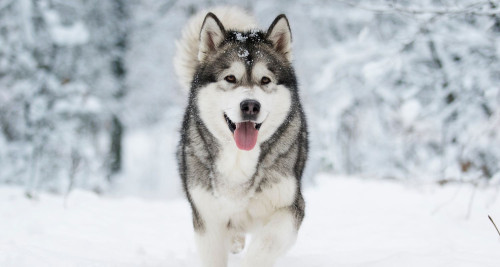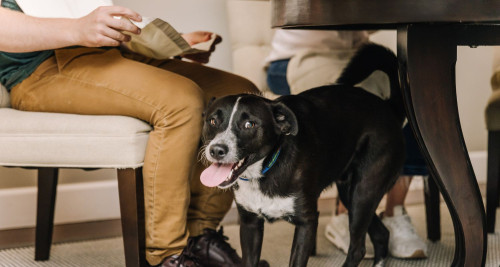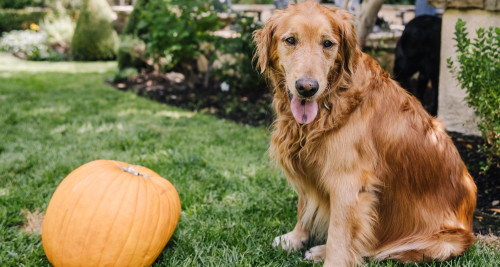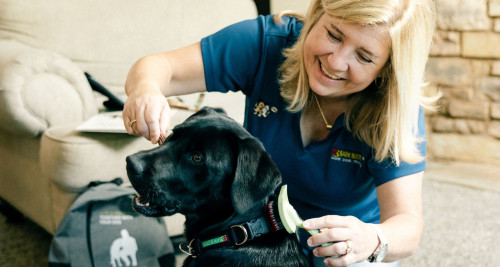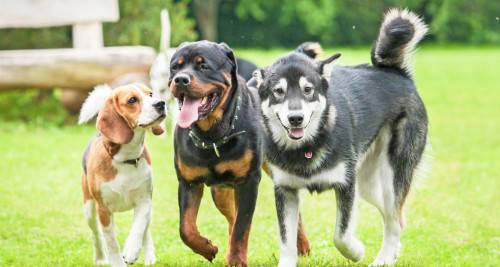The Boxer

Breed Traits and Characteristics
According to the American Kennel Club, here are some breed characteristic you can find in Boxers.
- Height
23-25 inches (male), 21.5-23.5 inches (female)
- Weight
65-80 pounds (male), about 15 pounds less
- Life Expectancy
10-12 years
- Coat Type/Length
Smooth/Short
-
80 Affectionate with Family
-
100 Good with Young Children
-
60 Good with Other Dogs
-
80 Trainability Level
-
80 Energy Level
-
60 Barking Level
-
20 Shedding Level
-
60 Drooling Level
History
Boxers originated in Germany and were bred as bull-baiting dogs and then butcher’s helpers, assisting in controlling cattle in slaughterhouses. They descended from a long line of bullenbaiser breeds (bull biters) that were used to hunt boar, bear, and bison on large estates. Boxers were eventually bred with Bulldogs and even Great Danes.
Boxers were invaluable in the World Wars carrying ammunition, messages and supplies. Some of the soldiers fell in love with the dogs and brought them home with them. There are various theories about the origin of their name. Some say it comes from the German word boxl (nickname for one of the Boxer’s ancestors), whereas others think it comes from the way they use their fore paws like a boxer in the ring.
The first boxer was registered by the AKC in 1904 and the first AKC Championship was won in 1915. They really became popular in the U.S. in the 1950s when Bang-Away, a Boxer, won the Westminster dog show. Now the boxer has become extremely popular, always appearing in the top 10 breeds.
The Boxer
Who doesn’t fall in love with their wrinkled, worried faces? Their imposing stares, noble posture and jaunty gait? Don’t be fooled. Behind that stern façade lies one of the friendliest, most playful and loyal breeds Bark Busters has ever had the pleasure to train.
And training they will need! Boxers are highly energetic and without consistent mental and physical stimulation, they can get into a lot of trouble! They love to jump on people, so it’s important to break this behavior as soon as possible. Because they are so people oriented, they do not like being alone, so separation anxiety can always be an issue.
Boxers are well-muscled and of medium in size weighing between 50 to 80 pounds and generally live 11 – 13 years. Their coloring is generally fawn, brindle or white. About 1 in 4 boxers are white, often with colored markings called “Checker boxers”. It is a misconception that white boxers are less healthy than other colors of boxers and always deaf because 14% are born deaf.
Many boxers have docked tails and cropped ears, although it is becoming more common among pet parents to not crop the boxer’s ears and just let them hang down.
If a boxer is joining your family, know that their intelligence, courage and easy-going nature makes them a great family dog!
Boxer Management
Boxers are unique in that they don’t fully mature until three-years-old, meaning their puppyhood seems to go on forever! Boxers can be stubborn dogs, so they require a strong leader. Early training is important before your Boxer gets too big. Like many of the bully breeds, Boxers do not train well using physical punishment or being bossed around. Instead, with methods like Bark Busters uses, Boxers respond better to their leaders after you have earned their respect.
Think about it. Dogs learn how to communicate with each other at their Mother’s teat. They use voice tones (growling, barking, yipping) and body language (stance, position of tail, etc.) Therefore, it is best to use this same method of communication when dealing with your boxer. Mother dogs speak dog and teach their pups the law according to the dog.
Boxers don’t tolerate the heat too well, so walks during the cooler times of the day are best. They don’t like extreme cold temperatures either because of their short coat, so a doggie coat might be the ideal thing for your Boxer if you live in a cold climate. Many pet parents kid that their Boxers' range of tolerance is between 72 and 74 degrees Fahrenheit (21-22 degrees Celsius).
Boxers love to play and make great family companions displaying the utmost in love and loyalty. Even though they are not small, they often think they are lapdogs! When they get excited they do a little dance called a “kidney bean” where they twist their bodies into a semi-circle or even a full circle. They also make a special sound called a “woo woo” when excited. Owners of boxers know what I am talking about!
They can be headstrong, meaning you will have to have patience when training them. They can become overexuberant and in their zest to protect their family, can lead to some aggression, so training in good doggie manners, is advised. Early socialization is important so they become exposed to different sights and experiences. Exercise is key to keep their energy in check -- the boxer is a big dog and can do a lot of damage if he's bored or lonely.
Boxers Personality & Temperament
Characteristics
- Smart, friendly, fearless
- Loyal and graceful
- High energy and like to stay busy
- Great guard dogs
- Must be exercised regularly
- Don’t do well in hot weather (overheating) or cold weather since they are short coated
- Tend to snore and snort
- Initially distrustful of strangers particularly if they sense a threat to their family
- Will jump, twist and somersault to entertain humans
Fun Facts about Boxers
- Because of their playful nature, they are sometimes called the “Peter Pan” of dogs.
- Their short muzzles can cause them to snore.
- A boxer holds the world record for the longest tongue – 17 inches.
- Boxers are cousins to the bully breeds.
- According to the AKC, the boxer was one of the first breeds used for German police training.
- It is a myth that all white boxers are deaf – only 12 to 14% are.
Capabilities
Boxers are excellent guard dogs and have an above average IQ, making them diverse in the roles they can play. Boxers love to be active and are perfect for agility, obedience and flyball.
- Athlete
- Cattle dog
- Show dogs
- Police dog
- War dog
- Dog for the blind
- Search and rescue
Boxer Behavior, Temperament & Training Tips
Boxers are one of the most recognizable breeds—athletic, expressive, and full of joyful energy. Known for their “superball” enthusiasm, Boxers bounce, jump, and play with an intensity that makes them lovable and sometimes a little challenging. While their fun-loving nature and intelligence make them wonderful family dogs, they also require clear communication, consistent leadership, and plenty of physical and mental stimulation to keep unwanted behaviors in check.
Common Boxer behavior issues include jumping on people, pulling on leash, counter-surfing, rough play, and excessive barking—especially if their natural guarding instincts go unmanaged. Because they’re strong, energetic, and highly social, Boxers thrive when owners establish structure early and give them outlets for both physical exercise and “brain work.” Without guidance, boredom can quickly turn into destructive chewing or attention-seeking behavior.
Despite their energy, Boxers are deeply affectionate, expressive dogs who bond strongly with their families. They’re typically great with kids when properly supervised and trained, and they excel in active homes that enjoy running, hiking, or playing outdoors. Their athleticism also means tools like the Bark Busters Wagg Walker® can help immensely with polite leash walking.
At Bark Busters Home Dog Training, our trainers love working with Boxers. Our method—based on voice tone, body language, and natural canine communication—helps owners quickly address jumping, leash manners, barking, and impulse control without treats or harsh corrections. With the right leadership and mental stimulation, Boxers are incredibly quick learners who eagerly respond to clear direction.
Whether you’ve brought home a Boxer puppy, rescued an adolescent Boxer, or are struggling with behavior issues, Bark Busters can help you build a relationship based on trust, love, and respect—bringing out the best in this intelligent, spirited breed.
Boxer Common Behavioral Issues
Boxer puppies need socialization as early as possible and firm but fair training. Boxers need to be positively motivated and love praise. Establishing yourself as the alpha dog and providing a consistent and structured environment goes a long way with a boxer.
Remember that your dog wants to please you – he just doesn’t know how. He will challenge you for control if he suspects you are not going to be a strong leader. Letting him know who is in charge and earning his respect upfront is key to successful training.
Boxers tend to have a mind of their own. Remember that boxers don’t like to be left alone, so separation anxiety can be a problem. They respond best to firm but fun training to help overcome their jumping, biting, barking and other mis-behaviors. Praise should be a major part of your training program.
An essential part of your training must involve exercise. Because of their high energy, a rousing game of fetch, or a long walk daily is a good idea. Remember that a bored dog is a mischievous dog.
Separation Anxiety
Some Boxers don’t do well when left home alone. They just don’t like solitude (especially if their doggie parents have never prepared them for it).
Things like leaving the home for a few minutes, but staying close by, to gauge your Boxers reaction to being left alone.
Leaving durable toys or treat-dispensing toys with your dog can help break the boredom, but sometimes they just want you.
This might sound great since anyone would want to be loved that much? However, the issue is that you might never be able to leave your dog at home alone while you go out to the movies or a meal.
It is best to start practicing separation from your Boxer as soon as you can. For example start off by teaching your dog not to follow you from room to room. They need to understand that they cannot always follow wherever you go.
If your dog sleeps with you or a family member, that might seem like a wonderful thing and no issue if your dog does not suffer Separation Anxiety, but a problem if it does.
The reason is your dog never gets to experience separating from you or the family when you are at home and the only time you do is when you all go out.
So practice separating, stopping your dog from following you everywhere you go and understand that the wanting to be with you all the time, might not be love, but could be the start of Separation Anxiety.
Connect with Us!
Need help training your Boxer? Call 1-877-500-BARK (2275)or enter your zip code.
Boxer Health
Common Injuries and Illnesses
Your Boxer's health concerns will change over the course of their life. A puppy might be more prone to eating something they shouldn’t, a 2-year-old Boxer is more likely to develop a cancerous mass, and a senior Boxer may develop urinary tract infections as they age. Boxers also have personality and physical traits that may make them more prone to certain conditions—they’re prone to heart conditions as they age, and tend to be active dogs that can injure themselves when playing or running.
If you are ever concerned about your dog’s health, your local veterinarian is a great resource—no matter how small the question.
At any stage of life, here are some of the most common injuries and illnesses you should be aware of when bringing home a Boxer:
- Cruciate ruptures
- Allergies
- Eye conditions
- Lymphoma
- Arthritis
- Masses
- Heart problems
Genetic Health Concerns
Like many popular breeds, the Boxer has a number of hereditary health issues, like eye conditions and heart problems. Boxers are also susceptible to allergies and multiple types of cancer. Most reputable breeders now have their breeding stock checked and scored for these hereditary ailments by a vet. You can request proof that the puppy you are purchasing comes from parents that have been checked for these issues.
Because many other health issues are also hereditary, you should do some research on the ancestry of your puppy and any health issues of that particular breed.
Many rescue organizations also check for common-ailments before making them available for adoption.
Tips For Every Dog Owner
Hear from Bark Busters Clients Who Have a Boxer
Unlock Your Boxer's Full Potential: Complete Our Form and See How Professional Training Can Help!
Confirm your zip code and complete this quick form, and we’ll reach out within 24 hours by email or phone to discuss your dog’s training needs. Skip the hassle of group classes with personalized, in-home training near you.
- 99.7% 4 or 5 stars 99.7% rate their experience with Bark Busters as 4 or 5 out of 5 stars.
- 99.6% Would Recommend 99.6% would recommend Bark Busters to their friends and neighbors.
- 99.5% Dog Responded 99.5% think their dog responded well to the training.
Need Dog Training Assistance with Your Boxer? Find Your Local Trainer Now!
CALL TODAY 1-877-500-BARK (2275)
